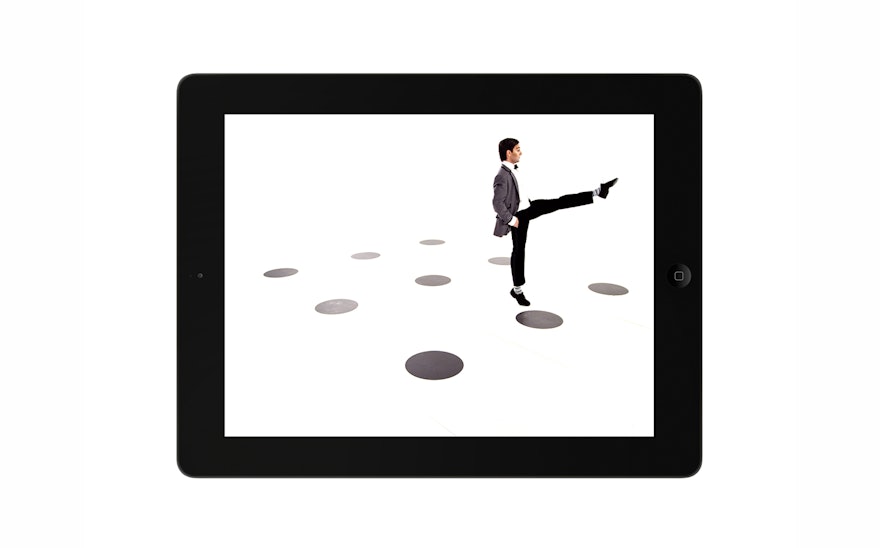The iPad offers a uniquely interactive performance space that presents new opportunities for dance and choreography. DOT DOT DOT is an app that invites viewers to interact with a dance designed, choreographed and scored for the digital tablet. Conceived and designed by Pentagram, the app is our latest collaboration with 2wice Arts Foundation, this time with dancer Tom Gold.
DOT DOT DOT uses a graphic interface of black and red dots that establish a diagrammatic space for a series of vignettes that users activate through the touchscreen. The app can be viewed in different registers that are accessed by swiping vertically and horizontally. Seen from above, the dots on the stage trigger different actions when touched. Seen from the side, the dots become columns that define the dancer’s movements. Another vertical swipe accesses a choreographic sequence seen from the corner of the stage. Along the way, Gold bounces across dots, spills a bucket of paint, and dances with his multiple selves; in another section of the app, the dots have morphed into a series of columns that form an increasingly dense forest. As he performs within this graphic environment, he presents himself as an intrepid performer, an avatar for the viewer.
The concept required a performer who would capture an elegant sense of style and comedy reminiscent of the movie musical genre. Gold responded with a performance that perfectly conveys the spirit of the app. An internationally recognized dancer and choreographer who was a star soloist for the New York City Ballet, Gold now leads his own group of dancers. Music for DOT DOT DOT was composed by the acclaimed violinist Charles Yang.
DOT DOT DOT follows "Fifth Wall," an app that placed the performer in the “box” of the tablet screen; the new app plays with the same scale relationship, but uses the tablet to give new perspectives on the performance. The designers got the idea for the new app while filming “Fifth Wall.” Where “Fifth Wall” played with the ambiguous gravity and disorientation of a four-sided box, DOT DOT DOT places a greater emphasis on the relationship of the dancer to the music, and to the ways the dance is activated by the user. The mood of the piece is playful; the big, graphic dots provide an exaggerated, comical button-based interface. The designers were partly inspired by a famous scene from the film “Bombay Talkie,” in which dancers are seen performing on the keyboard of a giant typewriter.
Seen from overhead, the first section of DOT DOT DOT showcases the game-like aspects of the app, featuring multiple Golds facing off on a field of pulsing, illuminated dots that are reminiscent of simple elements from early video games. The succeeding “levels” show a scrolling sequence where the dots become a series of columns, gaining in number to create a forest that Gold dances through. This is followed by a series where the camera is moving with Gold through the space. The final level allows Gold to perform uninterrupted, showing the full choreographic sequence of “Dot Dot Dot” accompanied by the music composed for the app by Yang.
The production had its challenges. The team had to figure out the logistics of a performance and shoot that were happening in the abstract confines of the tablet. Before building the stage, the designers established the spacing for the dots based on Gold’s jumping distance on a practice playing field. The team and videographer Ben Louis Nicholas had to calculate the correct camera height and focal length to maintain a cohesive sense of depth and continuity throughout the app’s various levels, and then keep track of the many repetitive motions required to populate the different dot sequences. To film the final version, the designers constructed a raised platform for the set with dots cut into the stage and 12-foot-high columns.
Pentagram also developed the coding of the the various elements, creating a seamless interface that balances the interactivity of a video game with physical objects moving in a dimensional space. Particular care was taken during editing to key the music to the dance. Violinist Charles Yang created 31 different tracks based on Gold's movements, producing a rich interplay of interface, movement, and sound.

